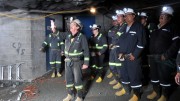Just brilliant! The mining industry is in urgent need of redemption but, at conferences in January, mining executives have aligned themselves with the Kingdom of Saudi Arabia (KSA) and an elitist club operating from a Swiss ski resort. The general public is hardly likely to be won over by our partnering with right-wing royalty in Riyadh and the World Economic Forum (WEF).
In the past, miners have been accused of being so focused on their own operating performance and corporate development that they failed to notice what was important for the whole industry; of not seeing the forest (or ‘wood’ in the U.K.) for the trees. I suspect that now, however, the pendulum has swung too far towards postulating about the far future, and we are losing sight of the trees. The industry needs to attend to more immediate woes, in particular the collapse in public support — from which flows, indirectly, the very serious issues of skills shortages, delays in planning approval and insufficient funding.
Mining requires a ground-up, practical, initiative and the forest-trees idiom gives a clue to the solution. We must rebuild plank by plank, and copy what the Welsh are doing for a 15th century ship found buried in a river bank near Newport.
The 35-metre-long wine-trading vessel sank in 1469 after breaking its moorings on the river Usk. Discovered in 2002, the ship would have weighed some 400 tonnes fully laden but the surviving structure weighs only 25 tonnes. Over the past 20 years the individual timbers have been removed and £8 million (US$10 million) spent preserving and restoring the wood. This has included freeze-drying at the Mary Rose museum in Portsmouth (Mary Rose was Henry VIII’s flagship naval vessel that sank in 1545 and was recovered in 1982).
The timber was also checked against the U.K.’s dendrochronology database, which utilizes radiocarbon dating and the unique grain patterns in wood. Timber can be dated as far back as 12000 BC, and the database can even pinpoint where the original trees were growing. It seems that the trees for the Newport ship’s wood were felled during 1449 in northern Spain (although the wine came from France).
It was announced in mid-January that the restoration process is complete. After spending over 530 years buried in Welsh mud, the planks are properly dried out and will be put on display. The reassembly can now begin, and with almost 2,500 pieces (and no flatpack instructions) it has been called the world’s largest 3-D puzzle.
The Newport vessel dates from the dawn of European maritime exploration and it sank 23 years before Christopher Columbus ‘discovered’ America.
Discovery of new lands, and the prospect of traded riches, reminds us that the mineral prospectivity of the Arabian-Nubian Shield is not in doubt, and Saudi Arabia offers a potentially lucrative hub for the region. This should not disguise the fact that the country is hardly an ideal partner to improve the immediate standing of the global mining industry.
At the recent Future Minerals Forum in Riyadh, corporate leaders from BHP (Mike Henry), Rio Tinto (Dominic Barton), Barrick Gold (Mark Bristow) and Ivanhoe Mines (Robert Friedland), in particular, queued up to trumpet KSA’s role in providing guidance to the mining industry. The Arabian-Nubian Shield might be a profitable way forwards for individual mining companies, but the region’s leaders are a bad fit for our industry.
Similarly, if mining leaders think the annual meeting in Davos is likely to offer a solution to the industry’s short-term travails they are sadly mistaken. Instead, we need to empower our own trade organizations to drive the industry forwards. The Prospectors & Developers Association of Canada and the International Council on Mining and Metals spring to mind, but they need to find a greater resolve, and grow teeth.
Certainly, Klaus Schwab’s organization isn’t the answer; the WEF can’t see the individual trees blocking our way because of its focus on the whole forest. We will be cut down long before Schwab’s vision for us comes to pass.
— Dr. Chris Hinde is a mining engineer and the director of Pick and Pen Ltd., a U.K.-based consulting firm. He previously worked for S&P Global Market Intelligence’s Metals and Mining division.






Be the first to comment on "The view from England: Unfortunate alliances by mining leaders"